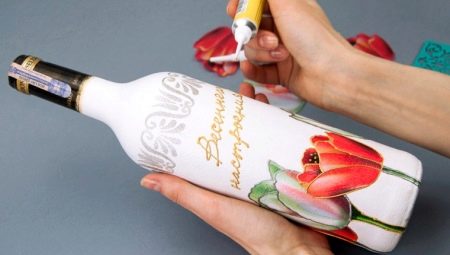It has long been customary to give a bottle of good wine, brandy, champagne, coming to visit. But this gift has become, perhaps, banal. Even if it's collectible alcohol. But what if you try an expensive bottle of interesting and unusual present? Decoupage technique will help us with this. And today we’ll talk about what it is and how to beautifully design a bottle of sparkling wine in this technique.

What is decoupage?
The French word découper is translated as “cut”. Using this technique, you can decorate any items, including furniture and lighting fixtures. Its essence is that a drawing, a picture, a piece of fabric, threads and other original objects are cut out in scale and shape, and are attached to the base (in our case, a bottle of champagne), i.e. an application is created.
The glued elements are necessarily varnished for durability and a special visual effect.
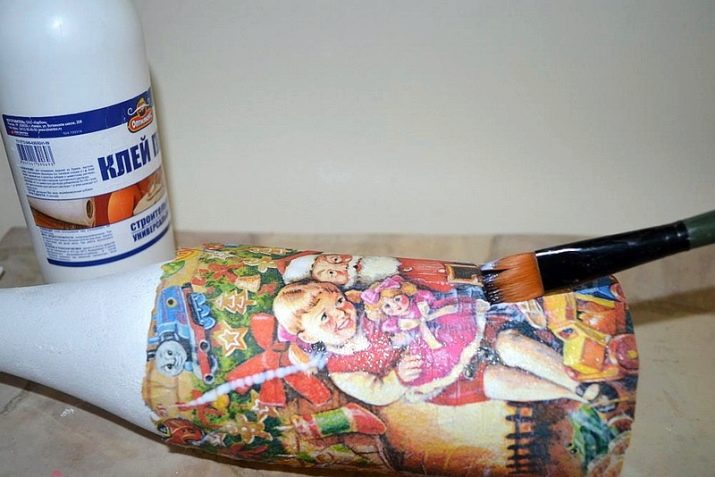
There are 5 types of decoupage, which can be combined on one item.
- Direct (classic) - this is the basis with which beginners begin. It is here that you can learn to properly stick decoupage napkins, pictures on cardboard, photographs onto a smooth surface. The surface will remain smooth, but updated. The drawing will cover the entire area, through it the previous background will no longer be visible.

- Reverse view used on transparent glass, so this option looks great on sparkling bottles. Here the picture is glued face to the glass, after which the whole bottle is decorated. You can view the picture through the window, especially left for this purpose.That is, the picture always remains behind the glass.

- Smoky (artistic) decoupage is not subject to everyone, because you need to know and be able to do shading, stretching the color, shadow. But having mastered this skill, you understand what unique works of art can be created from an ordinary thing. Art decoupage is most similar to a real picture with halftones and shadows, but it is also drawn around the applique.
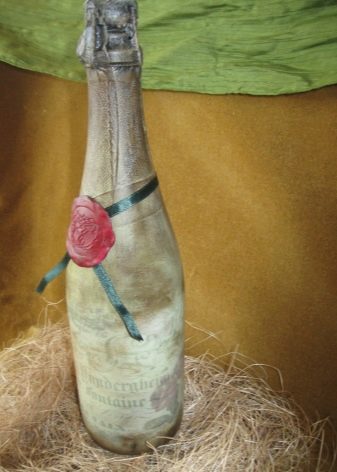
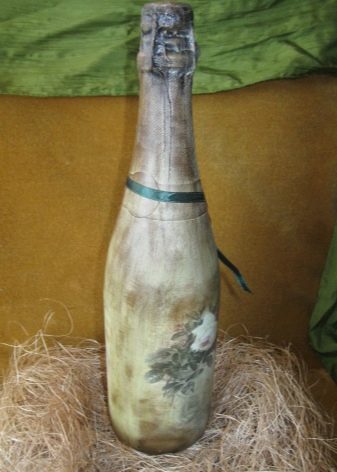
- 3D 3D technology allows you to make the work alive, emphasize individual elements. To do this, use modeling pastes, putty, fabrics, 3D decoupage cards, threads, twigs, flowers, glitters, decoupage contours, beads, rhinestones, eggshells and much more. Yes, even ordinary salt will make the picture voluminous.
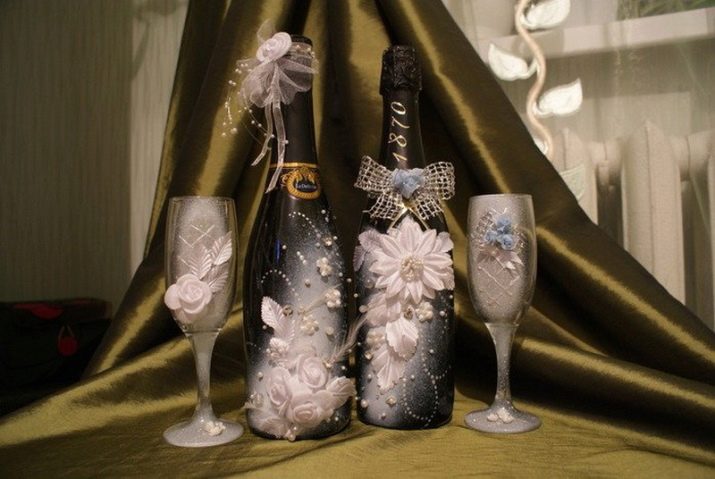
- Decopatch - This is a way of decorating by sticking small pieces of paper on the surface. It can be color and black and white newspapers, magazines, posters, sheet music. There is also special paper for decopatch. Depending on the style of sticking (adjacent or overlapping), the thing will look completely different, but it will necessarily create the illusion of cracking the surface.
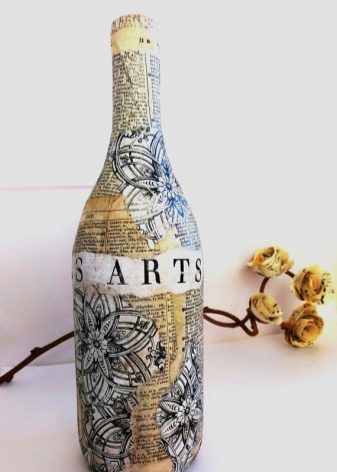

To create decoupage use several methods.
Wet
Technology will depend on the thickness of the image. Includes 3 methods.
- A napkin can be put on a file or a plastic bag, a drawing from yourself. Moisten thoroughly with a spray bottle and put another bag on top. Drive out excess water and air with a sponge, remove the top bag and carefully attach the picture file to the surface. Flatten and carefully remove the file, leaving a tissue, then grease with glue and allow to dry.
- Drawing on ordinary printed paper or cardboard is covered in several layers of transfer varnish and dried well. The back side is moistened with water and the white layer of paper is carefully removed by thinning. The remaining thin layer with a pattern is glued to the surface.
- The pattern is cut to size, smeared with glue on the front side and glued to the surface. After complete drying, the back (white) side is moistened with water and rolled up layers of paper with your hand.
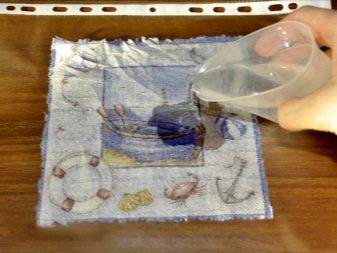
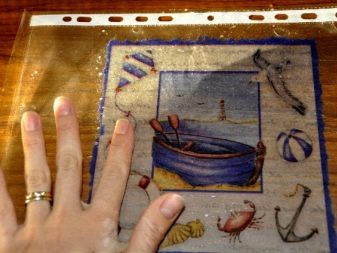
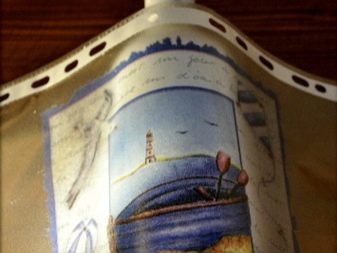
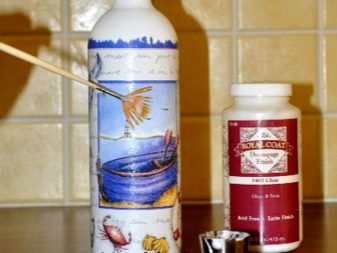
Dry
The drawing is covered with several layers of varnish, allowing each layer to dry well. Double-sided tape is glued to the back, and carefully peeled off with tape.
The thicker the paper, the more times you have to stick tape.

Hot
It should be applied on a flat surface. Neither glass nor plastic is suitable for this method. 2 layers of PVA glue are applied to the surface with a good drying of each. A dry paper or fabric picture with a motif is laid out on the surface, covered with parchment (cooking paper) on top. The surface is ironed with a hot iron, and the corners are especially carefully. The excess image is cut off, and after cooling, fix with varnish.
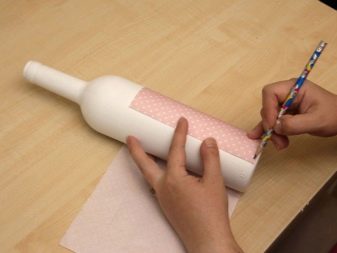

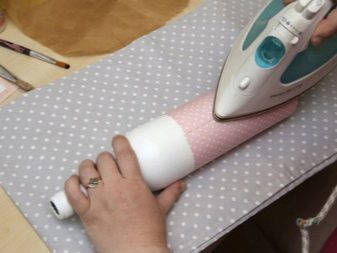
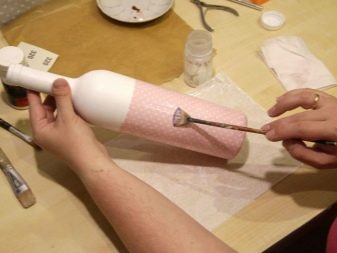
Professionals give novice decoupage artists a few tips:
- any surface must be thoroughly cleaned;
- the fragments on which the paint should not fall are sealed with masking tape;
- each coat of paint or glue should dry well;
- torn edges are much easier to mask than cut;
- expel excess water and air bubbles from the center to the edges.
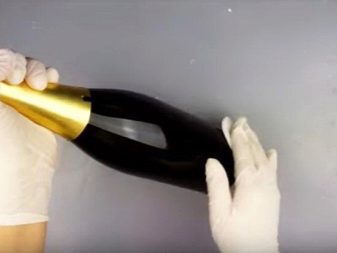

Necessary materials and tools
For work in the decoupage technique there is a certain obligatory set of tools and paints and varnishes. But for the decor you may need completely unexpected things: a handkerchief or nylon tights, juniper branches or eggshells.
Everything will depend on the artistic view of the author. The main thing - do not forget to buy a bottle of good champagne.
But we will list the tools and the required material:
- decoupage napkins or cards (pictures developed on the same theme, made on rice paper), printed photographs, fabric, that is, everything that contains the idea motive and will be glued to the bottle;
- acrylic paints of different colors or a lot of white paint and color;
- special brushes for decoupage or ordinary flat, but necessarily synthetic;
- decoupage adhesive of two types or PVA;
- acrylic varnish (transparent, transfer, finish);
- acrylic white primer;
- sponges (their role can be played by an ordinary kitchen sponge without a handle or pinned into a clothespin);
- degreaser, white spirit, acetone, alcohol, solvent (note that each type of surface needs its own degreaser so as not to damage the base);
- glitters suitable for the idea of colors;
- contours, including transparent;
- sandpaper of different grains;
- glue thermal gun, if it is planned to glue small parts such as artificial flowers, rhinestones, pebbles;
- spray paint;
- crystal paste;
- a set of palette knives;
- scissors;
- thin rubber gloves;
- hair dryer;
- Double-sided tape;
- cotton towel;
- stationery and kitchen knives;
- cotton pads;
- dishwashing liquid.

Bottle preparation
Cleaning the bottle is a prerequisite for a quality result. It is necessary to get rid of labels and glue residues: in slightly warm water the bottle should lie down for some time, after which the labels are removed from it with a sponge and knife. Any oil, including baby oil, cosmetic, massage, remove the remaining glue. The bottle is washed with a dishwashing detergent or something similar.
The preparation stage ends with degreasing - when working with glass, it is necessary to degrease. To avoid even handprints on the bottle, you need to work with gloves. Finally, the glass is dried with a towel.
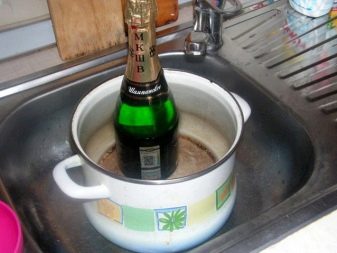
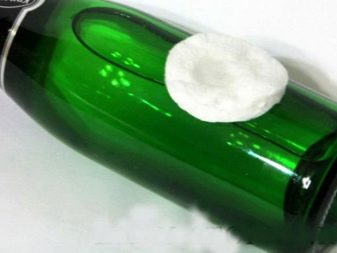
Interesting ideas and decoration instructions
To implement interesting ideas in a decoupage with your own hands, we offer a certain algorithm of actions. Depending on the materials selected, step-by-step instructions will vary, but the general logic will remain.
- In classic decoupage, a layer of acrylic primer is applied to a defatted bottle. Do it with a sponge. The first thin layer is dried with a hairdryer and the soil is applied repeatedly more densely. Many craftswomen in their master classes recall the need to paint the bottom.
- A layer with a pattern is removed from the decoupage napkin and gently break it along the contour. With this technique, the borders on the bottle are blurry and will not be noticeable.
- Using a dry or wet method, connect the napkin to the bottle. The main thing is that no air bubbles remain, and the edges are tightly glued. For beginners, decoupage painters recommend using decoupage glue spray. It allows you to tear off the napkin from the bottle with uneven gluing, straighten and glue again.
- When making applications from several fragments, it is important that they are not glued to each other. It is mercilessly tearing off the edges of the drawings, but making the surface monolayer.
- After the pasted napkin has dried, the image is covered with decoupage glue, but no longer spray. You need to do this very carefully to simultaneously straighten the picture. This stage also ends with drying, you can use a hairdryer.
- After applying all the pictures, the bottle is covered with 2-3 layers of acrylic varnish - this is protection against damage.
- But the decoration is just beginning. Next, you can use multi-colored contours to give clarity and volume to the details of the picture. Sparkles and glitters will make the picture bright. And ribbons, cones, sweets, doves will add specificity to the topic.
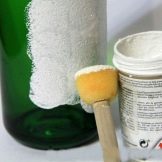
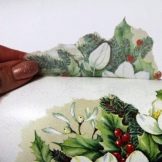


On March 8
On the first spring holiday, all girls (regardless of age) are waiting for at least a small bunch of flowers. And if there are no festive flowers in your village on March 8, then you can create a mimosa flower yourself from cotton balls or a yellow sponge by making volumetric decoupage. As branches, thuja or cypress are used.
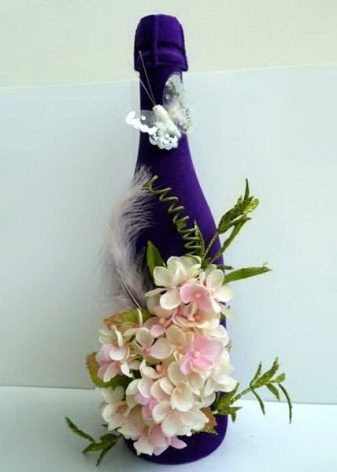
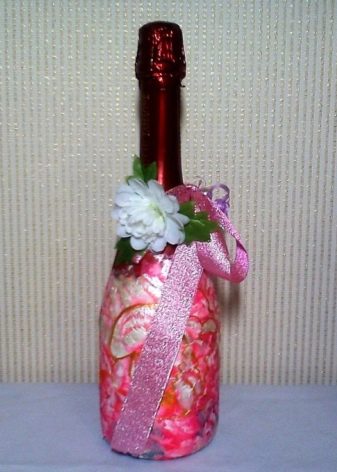
You can give a bottle of pineapple to the sweetener, where real candies are used as an application. The same bottle is even more interesting to make with reverse decoupage, and when you turn the “pineapple” through the glass, you will see a photograph of your beloved: mother, sister, girl, wife.
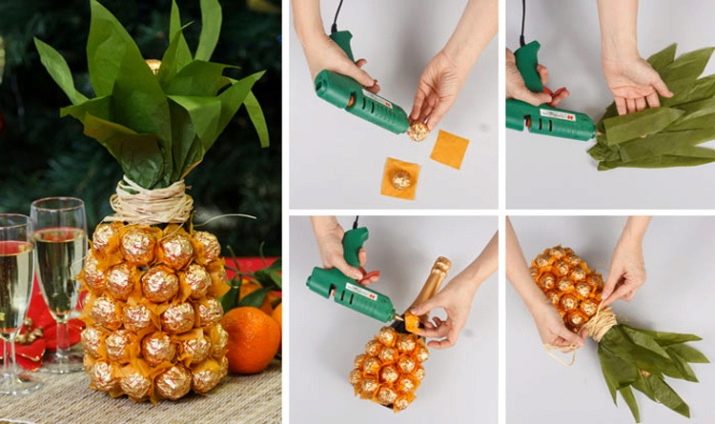
Girls love jewelry, and therefore it will be appropriate to use multi-colored ribbons as bows or serpentines, lace instead of a decoupage napkin or as a hat on the neck of a bottle, multi-colored threads of different textures.

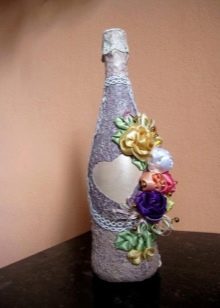
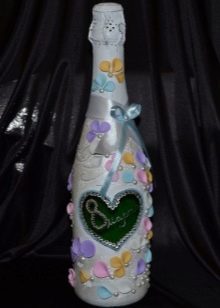
For a birthday
These same ideas are suitable for a woman’s birthday. But to show maturity, wisdom, you can use a cloth and design a bottle in various styles. For example, it will be a photo of a birthday girl framed by beautiful folds of expensive fabric. Or, perhaps, a more brutal version of the birthday man using army symbols, literary addictions, reminders of hobbies.
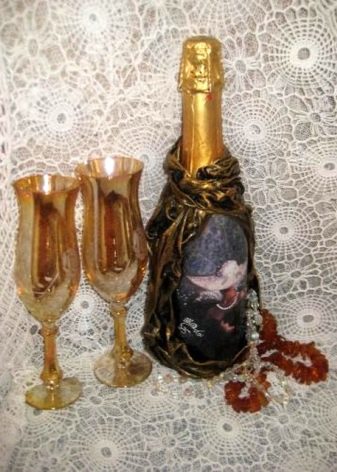
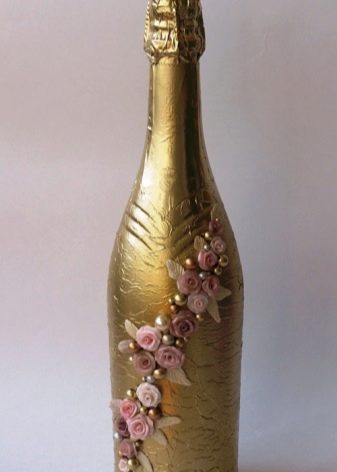
For other holidays
The most suitable holiday for champagne, of course, is the New Year. Stunning opportunities and ideas for decorating bottles using decoupage technique:
- twigs of living juniper or thuja will fill the festive table with forest aroma;
- to make the cones seem snowy, they need to be covered with white or silver spray paint;
- if you tie small toys or drawings of bullfinches on long threads to the neck of the bottle, it will seem that they fly with each movement of the bottle;
- after coating the bottle with glue or paint, it can be rolled over a layer of salt, and then crisp snow will appear on the glass.
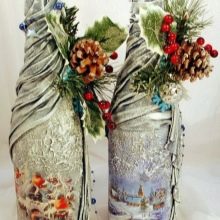
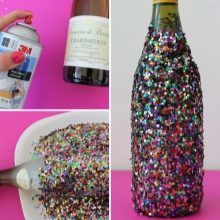
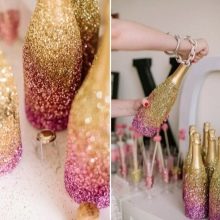
A wedding is another great reason to create a masterpiece using decoupage technique. Popular motifs: hearts, doves, rings, figures of the bride and groom.
Fresh flowers and sequins, beads and rhinestones are appropriate here. Indeed, for sure this bottle will be kept the whole life together.
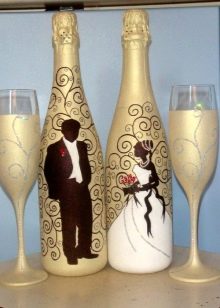
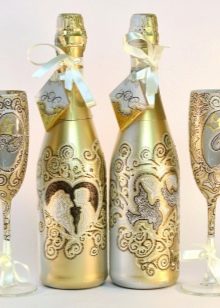
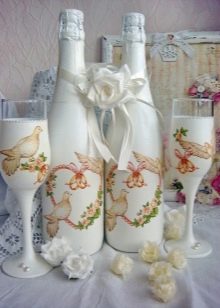
Watch a master class on the decoration of a bottle of champagne in the next video.
